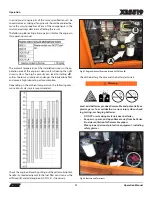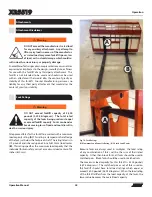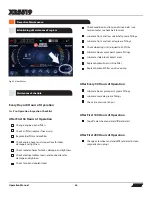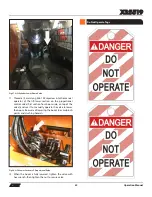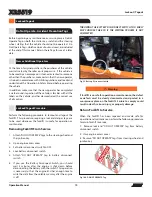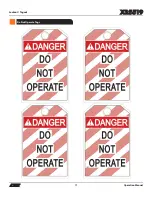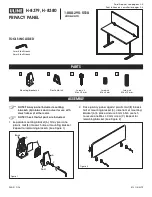
Operation Manual
64
XR5519
Operation
Load Capacity Charts
Warning
DO NOT exceed rated capacity. Any attempt
to lift or carry loads in excess of those shown
on the load capacity charts could cause fork-
lift tip over, loss of load, or structural damage
which could result in death, serious injury, or
property damage.
All load ratings shown on load capacity charts are based
on the forklift being on firm, level ground, the forks being
evenly positioned on the carriage, the load being centered
on the forks, properly sized tires properly inflated and/
or foam filled, and the forklift being in good operating
condition.
Using Load Capacity Charts
The reach forklift includes two (2) indicators to assist the
operator for accurately using the load capacity charts. These
indicators are the Boom Extend Letters and the Boom Angle
Indicator.
Boom extend letters are located on the left side of the boom
and visible to the operator as the boom is extended. These
letters indicate boom extension as it corresponds to the load
capacity charts.
Load capacity charts, located
in the center of the dash panel,
are provided to assist the
operator in determining how
to safely operate the boom to
pick up, carry, and set down
a load with the reach forklift,
including what angle, how
high, and how for to extend
the boom.
NOTE:
For example, when letter “A” first appears, the boom
extension corresponds to the arc of line “A” throughout all the
load capacity charts.
The boom angle indicator is located on the left side of the
boom and is visible from the operator’s seat. Use the boom
angle indicator to determine the boom angle when referring
to load capacity charts.
Fig 89. Boom Angle Indicator
Reading Load Capacity Charts
To accurately read the load capacity charts, you must
determine three (3) things:
•
Weight of the load being lifted
•
Height of structure where load is to be placed
•
Distance from front tires where load will be placed
For example:
1.
The operator determines load weight and makes sure load
does not exceed fork, attachment, or boom capacity.
The load is 2,430 pounds (1,102 kg)
2.
The operator safely moves the load to a loading position.
•
places forks under load
•
tilts and raises load safely
•
fully retracts boom
•
drives forklift to position perpendicular to structure
3.
The operator determines height of structure where load is
to be placed.
The structure height is 10 feet (3.04 meters) from ground level.
4.
The operator determines distance from front tires where
load will be placed.
The distance in front of forklift where load will be placed is 7
feet (2.13 meters).
Fig 87. Load Capacity Chart
Fig 88. Boom Extend Letters
NOTE:
The boom angle indicator is a plumb arrow with
angular graduations from -2.30 to +690.


